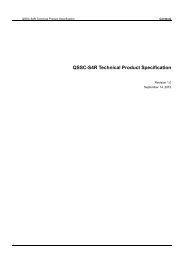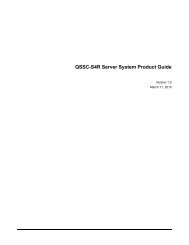Intel® Server System Server System "Emerald Ridge ... - CTL
Intel® Server System Server System "Emerald Ridge ... - CTL
Intel® Server System Server System "Emerald Ridge ... - CTL
Create successful ePaper yourself
Turn your PDF publications into a flip-book with our unique Google optimized e-Paper software.
錯 誤 ! 尚 未 定 義 樣 式 。 EPSFunctional Specification3.4 <strong>System</strong> InitializationThe following items are initialized by both the BIOS and the BMC during system initialization.3.4.1 Processor TControl SettingProcessors used with this chipset implement a feature called Tcontrol, which provides aprocessor-specific value that can be used to adjust the fan control behavior to achieve optimumcooling and acoustics. The BMC reads these values directly from the CPU via PECI. The BMCuses these values as part of the fan speed control algorithm. See Section 3.16.4.2.3.4.2 Fault Resilient Booting (FRB)Fault resilient booting (FRB) is a set of BIOS and BMC algorithms and hardware support thatallow a multiprocessor system to boot even if the bootstrap processor (BSP) fails. Only FRB2 issupported, using watchdog timer commands.FRB2 refers to the FRB algorithm that detects system failures during the POST. The BIOS usesthe BMC watchdog timer to back up its operation during POST. The BIOS configures thewatchdog timer to indicate that the BIOS is using the timer for the FRB2 phase of the bootoperation.After the BIOS has identified and saved the BSP information, it sets the FRB2 timer use bit andloads the watchdog timer with the new timeout interval.If the watchdog timer expires while the watchdog use bit is set to FRB2, the BMC (if soconfigured) logs a watchdog expiration event showing the FRB2 timeout in the event data bytes.The BMC then hard resets the system, assuming the BIOS selected reset as the watchdogtimeout action.The BIOS is responsible for disabling the FRB2 timeout before initiating the option ROM scanand before displaying a request for a boot password. If the processor fails and causes an FRB2time-out, the BMC resets the system.The BIOS gets the watchdog expiration status from the BMC. If the status shows an expiredFRB2 timer, the BIOS enters the failure in the system event log (SEL). In the OEM bytes entryin the SEL, the last POST code generated during the previous boot attempt is written. FRB2failure is not reflected in the processor status sensor value.The FRB2 failure does not affect the front panel LEDs.3.4.2.1 Watchdog Timer Timeout Reason BitsTo implement FRB2, during POST the BIOS determines if a BMC watchdog timer timeoutoccurred on the previous boot attempt. If it finds a watchdog timeout did occur, it determineswhether that timeout was an FRB2 timeout, system management software (SMS) timeout, or anintentional, timed hard reset. The BMC provides the IPMI Get Watchdog Timer command tofacilitate determining the cause of the watchdog time out.The BMC maintains the timeout-reason bits across system resets and DC power cycles, but notacross AC power cycles.Revision 1.1Intel ® Confidential 13









